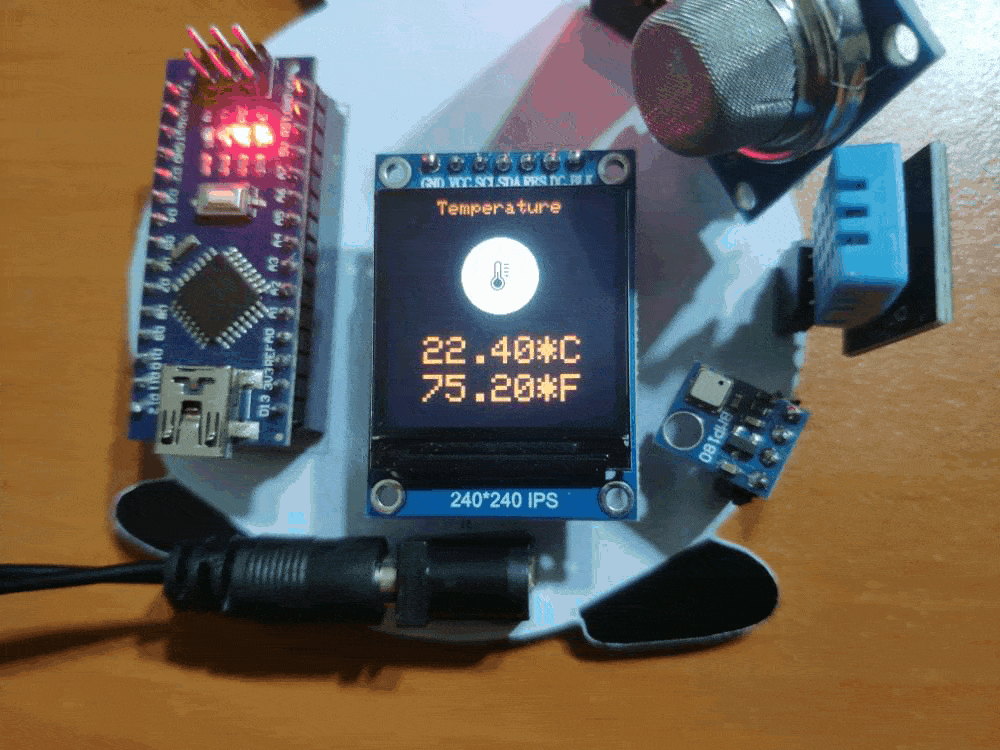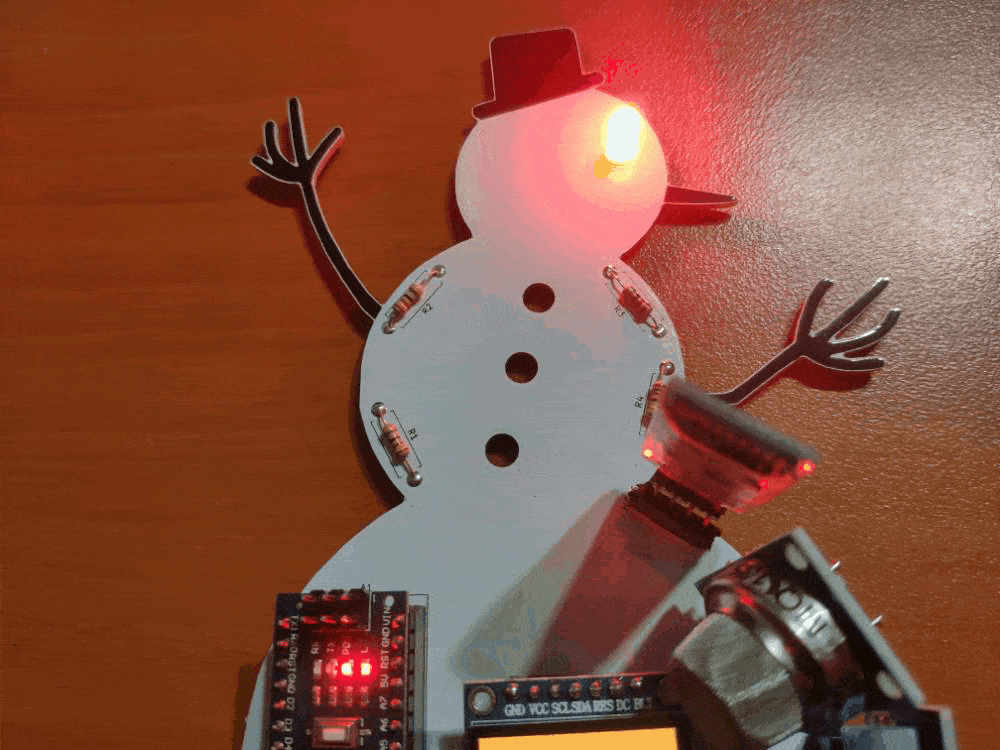- Temperature
- Humidity
- Pressure and Altitude
- Air Quality
- Animation
- Home Screen (Happy New Year)
First of all, I developed an Android application named Gift Card to control the gift card's modes and features via Bluetooth. And, therefore, I added an HC-06 Bluetooth Module to the gift card.
To be able to obtain weather information accurately, I used a BMP180 Barometric Pressure/Temperature/Altitude Sensor and a DHT11 Temperature/Humidity Sensor.
Then, to detect the air quality, I used an MQ-135 Air Quality Sensor with large-scale detecting scope and high sensitivity - NH3, NOx, alcohol, Benzene, smoke, CO2, etc.
Finally, I included an ST7789 240x240 IPS Screen to display each screen (mode) with colorful images and texts. Also, I added an RGB LED to the gift card as the eye of the snowman.
After completing my design on a breadboard and testing the code with the Android application, I designed a PCB (Snowman Gift Card) with a unique snowman shape to create an intriguing and apt gift card design for Christmas :)
I tried to keep components as simple as possible to integrate into the board to make this gift card easy-to-use even for novices and beginners who receive it as a gift for Christmas :)
Huge thanks to PCBWay for sponsoring this project.



Step 1: Designing and Soldering the Snowman Gift Card PCB
Primarily, I tested all connections and modules with the Arduino Nano on the breadboard.

Then, I designed the Snowman Gift Card PCB by using KiCad. I attached the Gerber file of the PCB below, so if you want, you can order this PCB from PCBWay to create a stylish snowman gift card to give your friends and family who can utilize its features as a home automation interface even to the next Christmas :)
Click here to inspect and order this PCB directly on PCBWay.


First of all, by using a soldering iron, I attached headers (female), 5mm RGB common cathode LED, 220Ω resistors, and the power jack.
Component list on the PCB:
A1 (Headers for Arduino Nano)
D1 (Headers for ST7789 240x240 IPS)
HC06 (Headers for HC-06 Bluetooth Module)
S1 (Headers for MQ-135 Air Quality Sensor)
S2 (Headers for DHT11 Temperature/Humidity Sensor)
S3 (Headers for BMP180 Barometric Pressure/Temperature/Altitude Sensor)
R1, R2, R3, R4 (220Ω Resistor)
L1 (RGB Common Cathode)
J1 (Power Jack)



Step 2: Developing the Gift Card Android application on the MIT APP Inventor 2
I chose to use the MIT APP Inventor 2 to create the Gift Card Android application due to its easy-to-use designer interface with drag and drop editor for simple functions. MIT App Inventor is a web application integrated development environment provided by Google and now maintained by the Massachusetts Institute of Technology.
You can download the apk file (Gift_Card.apk) of the Gift Card Android application from the Downloads below to install it on your phone or send it to people you want to present this gift card.
I also published the application on Google Play:
⭐ When installed, click the Connect button to view all paired Bluetooth devices.

⭐ Then, select the one named Gift Card (HC-06 Bluetooth Module) if not named differently by the user.

⭐ If the connection with the Snowman Gift Card PCB is successful after entering the given password (1234), the application prints Status: Connected. Otherwise, it prints Status: Error.

If you want to change the design of the application or view the source code to add new functions, follow the steps below:
⭐ Go to the home page of the MIT App Inventor 2 and click the Create Apps! button.
⭐ Then, import the aia file (Gift_Card.aia) of the application to the MIT App Inventor 2 to view the application settings and code.

⭐ The application has two screens, five switch buttons, one spinner, and one notification box. You can change their functions by using the Blocks editor.

Step 3: Programming Arduino Nano and setting up components
Download the required libraries to be able to control the modules:
BMP180 Barometric Pressure/Temperature/Altitude Sensor | Library
DHT11 Humidity and Temperature Sensor | Library
⭐ Include the required libraries.
⭐ Initiate the HC-06 Bluetooth Module. Connect the defined RX pin (7) to the TX pin on the Bluetooth module.
SoftwareSerial Gift_Card(7, 8); // RX, TX
⭐ Define the BMP180 sensor settings.
Adafruit_BMP085 bmp;double temperature, _altitude;int pressure, pressure_sea;
⭐ Define the DHT11 object.
DHT dht;float humidity, temperature_DHT;
⭐ Define the MQ-135 pin and RGB pins.
⭐ Define interface options - home, tem, hum, pres, air, ani.
⭐ Activate the Bluetooth module.
⭐ You can change the default settings of the HC-06 Bluetooth Module by uncommenting the changeBluetoothSettings() function - Name: Gift Card, Password: 1234, Baud Rate: 9600.
void changeBluetoothSettings(){ // Define the new settings. String Name = "Gift Card"; String Password = "1234"; String Uart = "9600,0,0"; Gift_Card.print("AT+NAME"); // Change the name. Gift_Card.println(Name); Serial.print("Name is changed: "); Serial.println(Name); delay(2000); Gift_Card.print("AT+PIN"); // Change the password. Gift_Card.println(Password); Serial.print("Password is changed: "); Serial.println(Password); delay(2000); Gift_Card.print("AT+UART"); // Change the baud rate. If the bluetooth module is a HC-05, the default value of baud rate is 38400. Gift_Card.println(Uart); Serial.print("Baud rate is set: "); Serial.println(Uart); delay(2000);
⭐ Check whether the BMP180 module is working.
⭐ Initiate the DHT11 Module.
⭐ In the Application_Commands() function, detect commands transferred by the Android Application (Gift Card).
void Application_Commands(){ // If the HC-06 Bluetooth module is receiving commands from the Android application: if(Gift_Card.available()){ char c = Gift_Card.read(); // Execute the requested command: switch(c){ case 'h': // Home Screen home = true; tem = false; hum = false; pres = false; air = false; ani = false; break; case '1': // Temperature home = false; tem = true; hum = false; pres = false; air = false; ani = false; break; case '2': // Humidity home = false; tem = false; hum = true; pres = false; air = false; ani = false; break; ...
⭐ Execute the requested command - home, tem, hum, pres, air, ani.
if(home == true){ tft.fillScreen(RGBto565(248, 178, 41)); while(home == true){ Application_Commands(); // Homescreen tft.setCursor(0, 40); tft.setTextColor(RGBto565(22, 21, 118)); tft.setTextSize(6); tft.println("Happy"); tft.println("New"); tft.println("Year:)"); } } if(tem == true){ tft.fillScreen(BLACK); while(tem == true){ Application_Commands(); // Collect data from the sensors - BMP180, DHT11, and MQ-135. collect_Data(); // Print: tft.setCursor(54, 0); tft.setTextColor(RGBto565(255,69,0), BLACK); tft.setTextSize(2); tft.print(F("Temperature")); tft.fillCircle(120, 80, 40, WHITE); tft.drawImageF(104, 64, 32, 32, temp); tft.setCursor(40, 145); tft.setTextSize(4); tft.print((String)temperature + "*C"); tft.setCursor(40, 185); tft.print((String)temperature_DHT + "*F"); } } if(hum == true){ tft.fillScreen(BLACK); while(hum == true){ Application_Commands(); // Collect data from the sensors - BMP180, DHT11, and MQ-135. collect_Data(); // Print: tft.setCursor(70, 0); tft.setTextColor(BLUE, BLACK); tft.setTextSize(2); tft.print(F("Humidity")); tft.fillCircle(120, 80, 40, WHITE); tft.drawImageF(104, 64, 32, 32, humd); tft.setCursor(50, 160); tft.setTextSize(4); tft.println((String)humidity + "%"); } } ...
⭐ In the collect_Data() function, get variables generated by BMP180, DHT11, and MQ-135.
⭐ Change the range of the air quality value (0 - 50) if your sensor readings differ.
void collect_Data(){ // Get variables generated by the BMP180 module. temperature = bmp.readTemperature(); pressure = bmp.readPressure(); pressure_sea = bmp.readSealevelPressure(); // Calculate altitude assuming 'standard' barometric // pressure of 1013.25 millibar = 101325 Pascal _altitude = bmp.readAltitude(); // Get variables generated by the DHT11 module. delay(dht.getMinimumSamplingPeriod()); humidity = dht.getHumidity(); temperature_DHT = dht.toFahrenheit(dht.getTemperature()); // Get variables generated by the MQ-135 sensor. air_quality = map(analogRead(mq135), 0, 850, 0, 50);}
⭐ In the adjustColor() function, adjust the color of the RGB eye of the Snowman Gift Card PCB.
⭐ In the Animation() function, create an animation screen using filled circles.
void Animation(uint8_t radius, uint16_t color) { int x, y, w = tft.width(), h = tft.height(), r2 = radius * 2; tft.fillScreen(BLACK); for(x=radius; x<w; x+=r2) { for(y=radius; y<h; y+=r2) { tft.fillCircle(x, y, radius, color); delay(100); // Halt animation if requested. Application_Commands(); } delay(100); }}




Step 3.1: Displaying images with the ST7789 240x240 IPS screen
Download the required libraries to be able to use the ST7789 240x240 IPS screen:
Arduino_ST7789_Fast | Library
Adafruit_GFX | Library
⭐ Define the ST7789 240x240 IPS display settings.
⭐ Initiate the ST7789 240x240 IPS display.
⭐ Open and clear the ST7789 240x240 IPS display.
#define TFT_DC 10#define TFT_RST 9#define SCR_WD 240#define SCR_HT 240...Arduino_ST7789 tft = Arduino_ST7789(TFT_DC, TFT_RST); ...tft.init(SCR_WD, SCR_HT);tft.fillScreen(BLACK);
⭐ Use the RGBto565() function to display RGB colors on the ST7789 as text and background color.
tft.fillScreen(RGBto565(248, 178, 41)); tft.setCursor(0, 40); tft.setTextColor(RGBto565(22, 21, 118)); tft.setTextSize(6); tft.println("Happy"); tft.println("New"); tft.println("Year:)");
⭐ Convert the images you want to display on the ST7789 screen to .c files by using the image converter below:

⭐ You can download the converted image files I used in this project in the Code - temp.c, humd.c, pre.c, and airq.c.
⭐ Include and print the converted images.
#include "temp.c"#include "humd.c"#include "pre.c"#include "airq.c"...tft.drawImageF(104, 64, 32, 32, temp);tft.drawImageF(104, 64, 32, 32, humd);tft.drawImageF(104, 64, 32, 32, pre);tft.drawImageF(104, 64, 32, 32, airq);
Connections and Adjustments
// Connections// Arduino Nano : // HC-06 Bluetooth Module// D7 --------------------------- TX// D8 --------------------------- RX// 5V --------------------------- 5V// GND --------------------------- GND// ST7789 240x240 IPS// GND --------------------------- GND// 3.3V -------------------------- VCC// D13 --------------------------- SCL// D11 --------------------------- SDA// D9 --------------------------- RES// D10 --------------------------- DC// BMP180 Barometric Pressure/Temperature/Altitude Sensor// A4 --------------------------- SDA// A5 --------------------------- SCL// DHT11 Humidity and Temperature Sensor// D2 --------------------------- S// MQ-135 Air Quality Sensor// A3 --------------------------- S// RGB LED// D3 --------------------------- R// D5 --------------------------- G// D6 --------------------------- B
After finishing and uploading the code to the Arduino Nano, I attached all required components to the board via headers - HC-06 Bluetooth Module, ST7789 240x240 IPS Screen, BMP180 Barometric Pressure/Temperature/Altitude Sensor, DHT11 Humidity/Temperature Sensor, and MQ-135 Air Quality Sensor.

Modes and Features
🎄⛄ In default mode, when the Snowman Gift Card starts working, it displays the home screen showing Happy New Year :)

🎄⛄ When the user clicks the Temperature switch button in the Gift Card Android application, the gift card displays the temperature variables generated by BMP180 (°C) and DHT11 (°F).



🎄⛄ When the user clicks the Humidity switch button in the Gift Card Android application, the gift card displays the humidity variable generated by the DHT11 (%).



🎄⛄ When the user clicks the Pressure and Altitude switch button in the Gift Card Android application, the gift card shows the pressure and altitude variables generated by the BMP180 (Pa / m).



🎄⛄ When the user clicks the Air Quality switch button in the Gift Card Android application, the gift card shows the air quality variable generated by the MQ-135 from 0 (OK) to 50 (DANGER).



🎄⛄ When the user clicks the Animation switch button in the Gift Card Android application, the gift card displays the animation pattern with the filled circles in the loop until the user selects other modes.



🎄⛄ The gift card adjusts the color of its RGB eye after the user selects any color option in the RGB Eye spinner in the Gift Card Android application:
- RED
- GREEN
- BLUE
- YELLOW
- PURPLE
- CYAN
- WHITE
- OFF (BLACK)






🎄⛄ If the user clicks the Exit button, the Android application shows the Disconnect notification box:
- Home Screen | Return to the home screen - Happy New Year :)
- OK | Close the application and disconnect Bluetooth!



Videos and Conclusion
After completing all steps above, I placed the Snowman Gift Card PCB as an ornament under my Christmas tree, waiting for commands from its Android application to run the requested modes. As well as being an entertaining decoration, it functions as an impressive home automation interface :)


 kutluhan_aktar
kutluhan_aktar